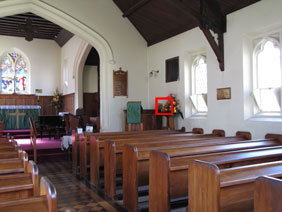Canon PowerShot SX20 IS
-
-
Written by Gordon Laing
Canon PowerShot SX20 IS vs Panasonic Lumix FZ38 / FZ35 vs EOS 450D / XSi High ISO noise
|
 | To compare noise levels under real-life conditions we shot this scene with the Canon PowerShot SX20 IS, Panasonic Lumix FZ38 / FZ35 and Canon EOS 450D / XSi within a few moments of each other using each of their ISO settings. The lenses on each camera were adjusted to deliver the same vertical field of view. |
The image above was taken with the Canon PowerShot SX20 IS at 6mm f3.2 and with a sensitivity of 80 ISO; the exposure was 1/4 of a second and the original JPEG measured 2.42MB. The crops are taken from the area marked with a red square and presented here at 100%.
Note the Canon 450D / XSi captures wider 3:2 aspect ratio images, so by matching the vertical field of view of the two superzooms, we’re effectively treating the DSLR here as a 10.8 Megapixel camera, delivering 4:3 shaped images. As such, the crops from this model show a slightly larger area.
Both super-zoom models share 12 Megapixel resolution and kick-off this sequence at 80 ISO. The Canon samples look colder, but that’s simply a difference in the way each camera has measured the White Balance in Auto, and shouldn’t be mistaken for a loss of saturation.
In terms of noise and actual detail, both cameras look pretty similar at this starting point. Look closely and you’ll see subtle noise textures on both samples, but that’s sadly par for the course on all compacts these days – at least those which use traditionally small sensors. There’s plenty of detail when viewed at 100% though and little to choose between them.
At 100 ISO there’s a fractional increase in noise on both super-zooms, but nothing to worry about. The Canon EOS 450D / Rebel XSi DSLR joins in at this point, delivering a sample which looks quite soft in comparison. This is normal when comparing the default output of most DSLRs and compacts, with the latter generally looking much punchier due to greater sharpening. You can of course apply more sharpening to the DSLR image in-camera or later if preferred, but the important thing to notice is the cleanliness of the image – no noise here.
At 200 ISO both super-zooms exhibit an increase in noise patterns, and the Canon has arguably softened very slightly, but again there’s little to choose between it and the Panasonic – once again the difference in colour is down to the White Balance, not a loss of saturation at higher sensitivities, at least not yet anyway. In the meantime, the DSLR sample remains completely clean. The low noise advantage of a DSLR is well-known at higher sensitivities, but some may be surprised to see a noticeable difference at relatively low ISO settings.
With the sensitivity increased to 400 ISO, both super-zooms are beginning to suffer with more obvious noise artefacts and a gradual loss of fine detail. Ignoring the difference in White Balance, they’re still quite close in terms of detail, but in our view the Panasonic FZ38 / FZ35 enjoys a small edge over the Canon. Once again the DSLR sample is clean and virtually noise-free.
At 800 ISO, both super-zooms take a noticeable swerve for the worst, and while the DSLR is also showing some noise, the advantage over a compact sensor is now really obvious. As for comparing the FZ38 / FZ35 against the SX20 IS, the Panasonic takes the lead at this point. Even taking the cooler White Balance of the Canon samples into consideration, it’s definitely losing more saturation now, and noise reduction artefacts are eliminating fine details. To be fair, the Panasonic samples are far from perfect at this point, but when viewed at 100%, they’re certainly looking preferable.
At 1600 ISO, the two super-zooms exhibit quite different approaches to noise reduction, but the bottom line is they’re both really struggling at this point to deliver anything usable. Canon’s smearing out noise and taking any detail with it, while Panasonic is leaving some strange-looking artefacts. Arguably the Panasonic looks better here with a more hands-off approach to noise reduction, but neither sample is looking pretty. The 450D / XSi DSLR is also exhibiting quite obvious chroma noise at this point, and there’s certainly better models around at the same sensitivities (most notably Nikon’s D5000), but again it remains vastly superior to what the super-zooms are delivering.
At 3200 ISO the 450D / XSi bows-out, leaving the super-zooms to bravely offer one final attempt at a very high sensitivity. Both models do so at a greatly reduced resolution and frankly look horrible. As always, these upper sensitivities are only really suitable for emergency use or greatly reduced sizes.
The big question of course is which is the better super-zoom – Canon or Panasonic? At first glance, the latter appears punchier throughout its range, but much of the difference in colour is down to the White Balance settings each camera selected in Auto. Take that into consideration and they’re actually pretty close, at least between 80 and 200 ISO. At 400 ISO and above though, the Canon employs more aggressive noise reduction, and even taking White Balance into account, its output looks softer than the Panasonic.
So if you regularly shoot at high sensitivities and view your images on-screen at 100%, you’ll prefer Panasonic’s approach over Canon’s, but for non pixel-peepers, they’re pretty close for general use. Ultimately the FZ38 / FZ35 does enjoy an advantage above 400 ISO, but arguably not enough to influence the decision between them for most people.
Now let’s check out more sample images across its sensitivity range in our SX20 IS Gallery!
Canon PowerShot SX20 IS |
Panasonic Lumix DMC-FZ38 / FZ35 |
Canon EOS 450D / Rebel XSi | ||
 |
 |
 | ||
80 ISO |
80 ISO |
80 ISO not available | ||
 |
 |
 | ||
100 ISO |
100 ISO |
100 ISO | ||
 |
 |
 | ||
200 ISO |
200 ISO |
200 ISO | ||
 |
 |
 | ||
400 ISO |
400 ISO |
400 ISO | ||
 |
 |
 | ||
800 ISO |
800 ISO |
800 ISO | ||
 |
 |
 | ||
1600 ISO |
1600 ISO |
1600 ISO | ||
 |
 |
 | ||
3200 ISO (at 2 Megapixels) |
High Sensitivity Preset at 1600 ISO |
3200 ISO not available |





